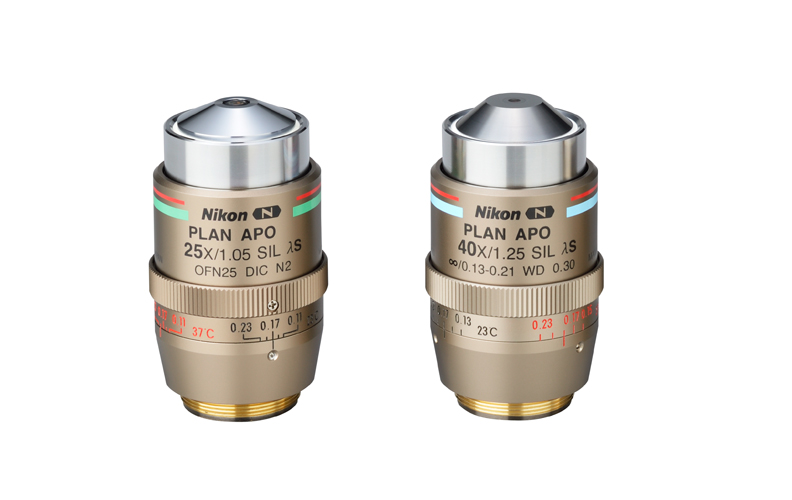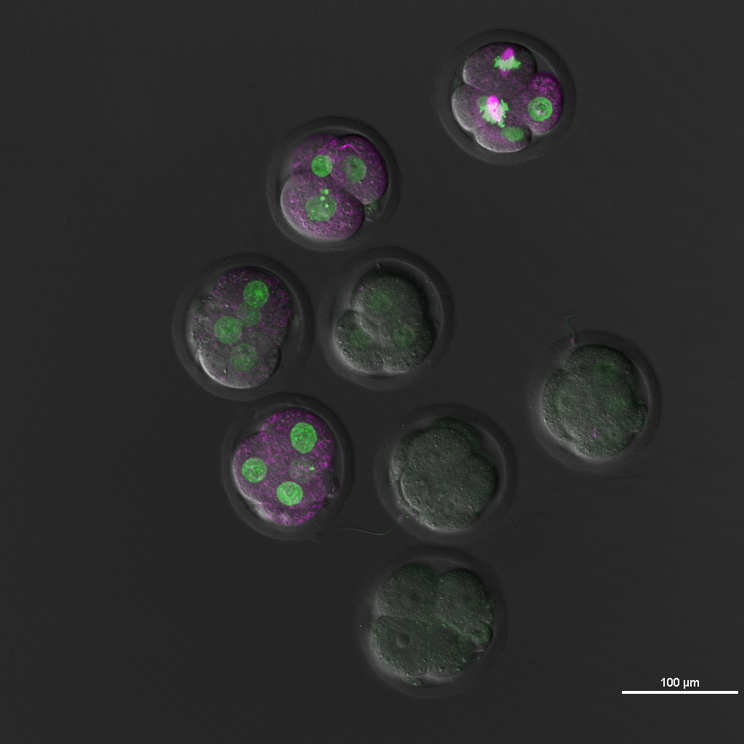April 23, 2019

Nikon Corporation (Toshikazu Umatate, President, Tokyo) is pleased to announce the release of two new silicone immersion objective lenses, the CFI Plan Apochromat Lambda S 25XC Sil and the CFI Plan Apochromat Lambda S 40XC Sil, for confocal laser microscope systems and Ti2 inverted research microscope. These lenses combine high numerical apertures (NAs) with large fields-of-view (FOV).
The use of silicone oil*1 for liquid immersion observation*2 enables ultimate clarity when imaging live, thick specimens.
- *1Silicone oil: closely matches the refractive index of live cells, making it suitable for long-time observation with its slower rate of evaporation.
- *2Immersion observation: An observation method that fills the area between the sample and the objective with immersion liquid. This method achieves a larger FOV and higher resolution than dry observation methods.
Product Information
| Product Name | CFI Plan Apochromat Lambda S 25XC Sil for biological microscopes CFI Plan Apochromat Lambda S 40XC Sil for biological microscopes |
|---|---|
| Availability | April 26, 2019 |
Product Concept
There is growing demand in the biomedical and regenerative medicine fields to observe thick samples such as organoids, embryos and live tissues. To meet such demand, Nikon has developed two new silicone immersion objectives featuring large fields of view, high-resolution, and long working distances, which can provide bright, high-resolution images even in thick, live samples. Maximum image clarity can be achieved when combined with confocal imaging systems.
Main Features
1. High resolution imaging of thick, live specimens
Spherical aberration resulting from refractive index mismatch is a common problem in live-cell imaging at high-resolution. Nikon’s new objectives are designed for use with silicone oil (ne≒1.40) which closely matches the refractive index of biological specimens (ne≒1.38), mitigating the mismatch and enabling brighter, higher-resolution 3D images of live cells and tissues, especially at greater sample depths. Furthermore, silicone oil does not evaporate, even at 37℃, enabling ultra-long observation periods. This is unlike evaporation issues that limit the use of water-immersion objectives for long time-lapse experiments.
2. High N.A. and large field of view
The CFI Plan Apochromat Lambda S 25XC Sil provides an N.A. of 1.05, and the CFI Plan Apochromat Lambda S 40XC Sil, an N.A. of 1.25. Their high numerical apertures combined with large, 25mm FOV*3enables high-throughput 3D data acquisition at high resolution.
- *3FOV (field of view): the diameter of the observable image in a microscope.
3. Long working distance
The CFI Plan Apochromat Lambda S 25XC Sil and CFI Plan Apochromat Lambda S 40XC Sil objectives provide long working distances*4 of 0.55 mm and 0.3 mm, respectively, for imaging thick samples.
- *4Working distance: The distance from the tip of the objective lens to the observation target when the target is in focus. A long working distance has numerous advantages, such as prevention of contact with the sample when changing objectives.
Specifications
| Product name | CFI Plan Apochromat Lambda S 25XC Sil | CFI Plan Apochromat Lambda S 40XC Sil |
|---|---|---|
| Magnification | 25X | 40X |
| Numerical aperture (NA) | 1.05 | 1.25 |
| Working distance (WD) | 0.55 mm | 0.3 mm |
| Parfocal distance | 60 mm | 60 mm |
| Field of view (FOV) | 25 | 25 |
| Compatible cover glass thicknesses | 0.17 mm | 0.17 mm |
| Compatible correction range of cover glass thickness | 0.11-0.23 mm | 23℃:0.13-0.21 mm 37℃:0.15-0.23 mm |
Sample images
Acquired using the A1R HD25 confocal laser microscope system and CFI Plan Apochromat Lambda S 25XC Sil objective.
Dual-color fluorescence and DIC image of fertilized mouse eggs.
Image courtesy of: Dr. Yoshiteru Kai, Reproductive Medicine Research Center, YAMASHITA SHONAN YUME CLINIC

3D fluorescence image of a HeLa cell colony (approx. 80-120 µm thick; labeled for nuclei, actin and mitochondria) acquired using the A1R HD25 confocal laser microscope system and CFI Plan Apochromat Lambda S 40XC Sil objective





